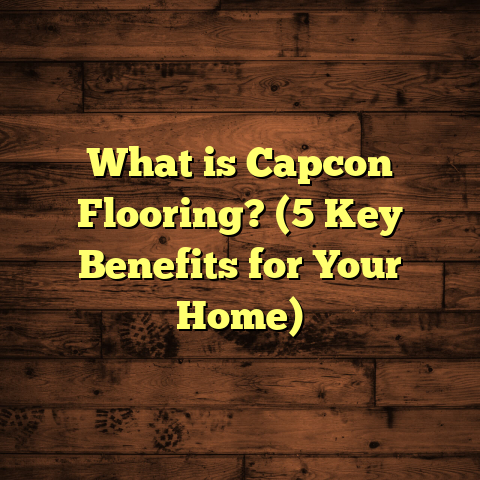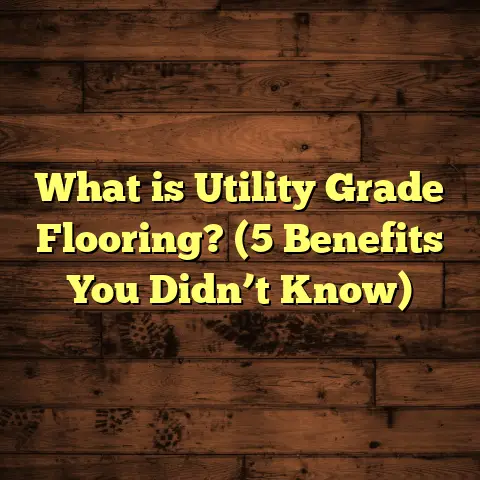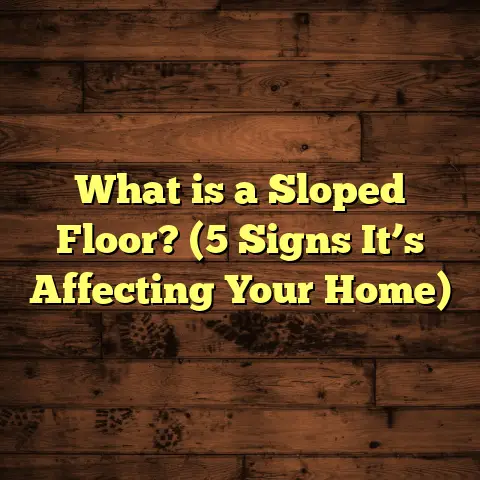What is a Floor? (5 Key Types in Home Design Explained)
What is a Floor?
When I think about floors, I realize they’re far more than just the surface we walk on daily. A floor is the foundation of any space — literally and figuratively. It’s the sturdy base beneath our feet that holds everything up, giving rooms their shape and character. But floors do much more than support; they set moods, influence how a space feels, and even affect how we live.
Simply put, a floor is the bottom layer of a room’s interior designed to cover and protect the subfloor — which is the structural layer beneath. It’s the finish that we see and interact with every day, whether it’s smooth hardwood, soft carpet, or cool tile. The choice of flooring can affect everything from aesthetics to comfort to functionality. I’ve spent years working with floors of all kinds, and I can tell you that picking the right one is both an art and a science.
Floors are often the first thing people notice when they enter a room — they speak to style and personality. They also have to perform well: withstand foot traffic, resist spills, and last for years without losing their charm. That’s why understanding the different types of floors and how they compare matters so much.
Let me walk you through five key types of flooring I often work with in homes, sharing my hands-on experience, key data points, cost insights, and some stories from real projects.
1. Hardwood Flooring: The Classic Choice
Hardwood floors have this timeless appeal that never fades. Whenever I install hardwood, I’m reminded why it remains one of the most popular flooring options decades after it first became mainstream.
What Is Hardwood Flooring?
Hardwood flooring is made from solid wood planks cut directly from trees like oak, maple, walnut, or cherry. Each plank is a single piece of wood that can be sanded and refinished multiple times over its lifetime. This ability to renew itself makes hardwood a long-lasting investment.
Each species offers different colors, grain patterns, hardness levels, and finishes. For example:
- Oak: The most common hardwood with warm golden tones.
- Maple: Known for its smooth grain and light color.
- Walnut: Darker and richer in color with unique grain patterns.
- Cherry: Deepens in color beautifully as it ages.
My Hardwood Experience
I remember working on a century-old home where the original hardwood floors were worn but salvageable. We refinished those floors instead of replacing them, which saved money and preserved history. The sanding brought out the rich character—scratches and dents told stories from decades past.
In another project, a client wanted a rustic look using reclaimed wood planks. These were not only beautiful but also environmentally friendly since we reused existing materials. The cost for hardwood typically ranges between $8 and $12 per square foot installed but can go higher for exotic species or custom finishes.
What Makes Hardwood Special?
- Durability: Hardwood can last 25 to 100 years depending on use and care.
- Refinishing: Can be sanded down multiple times to remove scratches or renew the surface.
- Aesthetic: Provides warmth and character unique to natural wood grain.
Industry Data
According to the National Wood Flooring Association (NWFA), hardwood flooring accounts for around 40% of all residential floor installations in the U.S. It continues to be favored for its ability to increase home resale value by up to 2-5%.
Challenges
Hardwood doesn’t like moisture. It can warp or swell in damp environments like bathrooms or basements unless specially treated or engineered for such spaces. It also requires regular maintenance like polishing or refinishing every 7-10 years depending on wear.
2. Laminate Flooring: Budget-Friendly Durability
Laminate flooring has become popular for homeowners who want the look of hardwood but need a more affordable and durable option.
What Is Laminate Flooring?
Laminate consists of multiple layers fused together:
- A high-density fiberboard core for strength.
- A photographic layer that mimics wood (or stone) textures and patterns.
- A protective wear layer that resists scratches, stains, and fading.
Laminate is not wood but engineered to look like it convincingly.
My Laminate Experience
I’ve installed laminate in rental properties where durability and cost are big concerns. One lesson I learned early on was to always choose laminate with at least an AC3 rating (abrasion class). This rating indicates it can handle moderate residential wear without wearing through quickly.
Clients love laminate because it’s easy to clean and install — usually floating over an underlayment without nails or glue. Installation costs run $2-$5 per square foot, making it attractive if you want the wood look without breaking the bank.
Durability & Maintenance
Laminate typically lasts 10-25 years depending on foot traffic and care. Unlike hardwood, it cannot be sanded or refinished; once damaged, you usually replace sections or the entire floor.
Water damage is a risk — laminate swells when exposed to moisture for prolonged periods. Newer “water-resistant” laminates have improved this but still don’t perform well in bathrooms or wet basements.
Advantages & Disadvantages
| Advantages | Disadvantages |
|---|---|
| Lower upfront cost | Cannot be refinished |
| Scratch-resistant | Less natural feel compared to wood |
| Quick installation | Swells if water penetrates |
Data Insight
Research shows laminate sales grew by over 25% in the last decade due to advances in design realism and durability improvements. For moderately trafficked rooms like living rooms or bedrooms, laminate presents excellent value.
3. Vinyl Flooring: Versatility Meets Practicality
Vinyl flooring has evolved dramatically over recent years. I often recommend vinyl when clients need something tough but stylish—especially for areas prone to moisture.
What Is Vinyl Flooring?
Vinyl is made from synthetic plastic materials (PVC). It comes in several forms:
- Sheets: Large rolls laid seamlessly.
- Tiles: Square pieces mimicking ceramic or stone.
- Planks (LVP – Luxury Vinyl Plank): Mimic hardwood with texture and grain detail.
Luxury Vinyl Plank is especially popular because it combines durability with design versatility.
My Vinyl Experience
In bathrooms, kitchens, or basements where water exposure is common, vinyl has proven its worth repeatedly. Once, a client was worried about spills damaging their floor after installing granite countertops in the kitchen. We installed LVP with waterproof backing—easy to clean and comfortable underfoot.
Vinyl costs vary widely:
- Basic vinyl sheets: $1-$3 per sq.ft installed.
- Luxury vinyl planks: $3-$7+ per sq.ft installed.
Performance & Longevity
Vinyl floors last 10-20 years depending on quality and traffic. They’re waterproof if installed correctly, making them ideal for wet rooms.
Pros & Cons
| Pros | Cons |
|---|---|
| Waterproof | Lower resale value than wood |
| Durable & scratch-resistant | Some cheaper types look fake |
| Soft underfoot | Can dent under heavy furniture |
Industry Trends
Vinyl accounted for around 30% of residential flooring sales in 2023 according to industry reports—showing strong growth fueled by improved aesthetics and ease of maintenance.
4. Tile Flooring: Longevity and Style
Tile is a timeless choice offering durability paired with endless design options.
What Is Tile Flooring?
Tile refers mainly to ceramic or porcelain tiles made by firing clay at high temperatures:
- Ceramic: More porous, less dense.
- Porcelain: Denser, less porous, more durable.
Tiles come in countless shapes, sizes, colors, patterns, and finishes—from glossy to matte—that allow for unique layouts.
My Experience With Tile
I’ve installed tile in high-traffic areas like kitchens, foyers, and bathrooms because it holds up against heavy use and spills beautifully. Tile floors can handle water without warping or staining but require proper grout sealing to avoid mold.
One memorable project was a kitchen where we designed a herringbone tile layout using porcelain tiles with a wood look — combining tile’s durability with hardwood aesthetics.
Tile installation is more labor-intensive than other floors:
- Costs range $5-$15+ per sq.ft installed.
- Requires precise subfloor prep.
- Grout lines need sealing every few years.
Durability Stats
Tiles can last over 50 years when maintained properly. They resist scratches, heat, stains, and water superbly.
Pros & Cons
| Pros | Cons |
|---|---|
| Extremely durable | Cold & hard underfoot |
| Water-resistant | High installation cost |
| Wide design variety | Grout requires upkeep |
5. Carpet Flooring: Comfort Underfoot
Carpet brings softness and warmth no hard surface can match. It’s still a popular choice for bedrooms and living areas where comfort is key.
What Is Carpet Flooring?
Carpet consists of fibers woven into backing material:
- Common fiber types: nylon (durable), polyester (affordable), wool (luxurious).
- Styles vary from plush cut pile to loop pile.
- Thickness affects softness and insulation properties.
My Carpet Stories
One family wanted cozy bedrooms for their kids with durable but soft carpet that could handle spills and dirt from playtime. We chose stain-resistant nylon with medium pile height—soft enough for comfort but resilient against wear.
Carpet installation costs vary widely—from $2 per sq.ft on budget options to $10 or more for premium wool variants.
Carpet Lifespan & Care
Carpet typically lasts 5-15 years depending on quality, foot traffic, and cleaning frequency. It requires regular vacuuming and periodic deep cleaning to maintain appearance and air quality.
Pros & Cons
| Pros | Cons |
|---|---|
| Soft & warm | Stains easily |
| Noise reduction | Needs frequent cleaning |
| Many colors & styles | Can trap allergens |
Comparing the Five Flooring Types
Here’s a side-by-side comparison based on my experience and data collected over years:
| Flooring Type | Cost per sq.ft Installed | Lifespan (Years) | Maintenance Level | Water Resistance | Installation Difficulty |
|---|---|---|---|---|---|
| Hardwood | $8 – $12 | 25 – 100 | Moderate | Low | Medium |
| Laminate | $2 – $5 | 10 – 25 | Low | Low | Easy |
| Vinyl | $1 – $7 | 10 – 20 | Low | High | Easy |
| Tile | $5 – $15 | 50+ | Moderate | High | Hard |
| Carpet | $2 – $10 | 5 – 15 | High | Low | Medium |
How I Estimate Costs Efficiently
Estimating flooring costs accurately can be tricky given so many variables—material choice, labor rates, waste factors (extra material needed), room complexity, etc. Over time, I’ve found tools like FloorTally extremely helpful in managing these variables efficiently.
FloorTally lets me input project specifics like room size, chosen materials, local labor prices, and even waste percentages (usually around 5%-10%). It then generates detailed cost breakdowns that closely reflect real-world prices from suppliers and contractors near me.
Using this tool saves me hours each week avoiding back-and-forth quotes while helping clients plan budgets realistically upfront. Plus, it helps me visualize total project costs clearly — so no surprises halfway through the job!
Flooring Stories from My Projects
I want to share some personal anecdotes about flooring choices from different homes I’ve worked on. These stories highlight how floors impact not just design but lifestyle too.
Story 1: The Busy Family Hardwood Challenge
In one home with four kids and lots of pets running around, hardwood seemed risky at first because it scratches easily. But we went with distressed oak hardwood combined with an extremely durable finish coating resistant to wear and tear.
The family loved how the floor softened over time with scratches blending into the rustic character instead of looking like damage. Their resale value jumped after just two years thanks to the beautiful hardwood throughout their main living spaces.
Story 2: Laminate Saves a Rental Budget
For an investor flipping several rentals quickly on a budget, laminate was perfect due to fast installation and affordability. We selected high-quality laminate with an AC4 rating ensuring good durability for tenants while keeping costs down under $4 per square foot installed.
Tenants appreciated the modern look resembling wood without worry about damage during their stay. Turnover times shrank because new floors went down fast—an ideal solution balancing function with style on a budget.
Story 3: Vinyl Victory in Wet Basements
Basements are tough spots for floors due to moisture risks. I used luxury vinyl planks with waterproof backing in two basement remodels recently that transformed those damp spaces into comfy guest rooms without worrying about warping or mold issues common with wood or carpet down below grade level.
Clients were thrilled with vinyl’s realistic wood look paired with water resistance—plus easy cleanup after kids tracked mud inside!
Final Thoughts
Floors might seem simple at first glance but choosing the right one involves many layers of thought—style, function, cost, maintenance—all tailored to how you live in your home.
From my years installing floors in countless homes:
- Hardwood offers unmatched longevity & timeless beauty.
- Laminate gives wood-like looks on a tight budget.
- Vinyl balances style & waterproof practicality.
- Tile delivers durability combined with style freedom.
- Carpet brings softness perfect for cozy zones.
Which floor fits your lifestyle best? Are you leaning toward something durable that lasts decades? Or maybe something soft and warm for relaxing spaces? Either way, knowing what each type offers will help you make choices that feel right every day when you walk across your space.
If you want help estimating costs or figuring out what works best in your home’s unique setting, don’t hesitate to reach out—I’m happy to chat flooring anytime!





